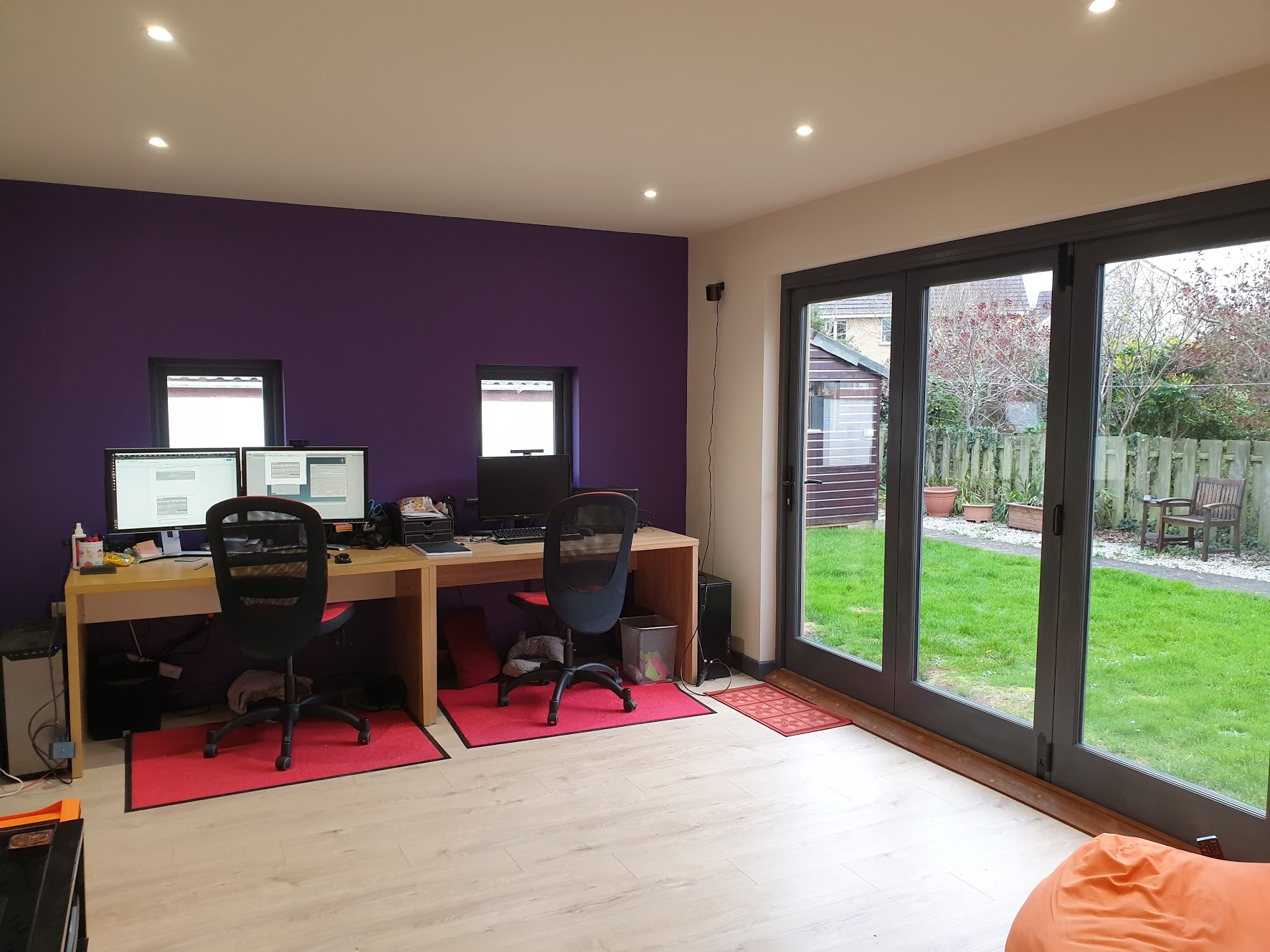This post was originally posted on the Triangular Pixels website.
More studios and individuals are having to move to remote working. We’ve been distributed since 2014 so thought we would share our years of advice!
Environment
The first thing you need to do is to ensure you create a good, clean working environment. Find yourself a desk area away from your living and bedroom space, that you can close the door on when you finish for the day. A lot of the stress we had when starting off was because we had our desks in the living room, which led to the constant reminder of work when we were trying to relax. It’s even worth clearing out the shed if you can make it a warm space.
Ideally you actually want to set up your desk where the sun comes in and close enough to a window so you can look outside. Office workers are terrible for having low levels of Vitamin D, so help counter that by working in the sun. Nature being just outside helps the soul, gives you a view that’s constantly changing, and a bit of company with the local wildlife.
As for accessories, get yourself a whiteboard, notebook and post-its. Any sort of thinking you would do in an office with others you would often do with physical media – so carry on doing so. It helps break up the time staring at a screen and get some of those thoughts out.
Create a proper desktop setup – with monitor, keyboard, speakers, mouse – and keep the laptop for special occasions, working out in the garden and personal play. It’s trying to separate personal time from work time, larger screen for work, and more comfort for your wrists. The laptop is your time away from your desk and work – even use different desktop wallpaper!
Make sure to create a “frictionless” environment with your actual PC rig. Clean out your hard drive to get plenty of space, and upgrade your PC so you’re not having to wait all the time for things. Sort out those things that have been bugging you! Any time you are waiting for loading bars at home makes for time away from being productive or relaxing – it’s an all too easy time to be distracted and not commit to work or play.
Of course since you’re doing to be communicating with people remotely – make sure to get a good webcam. We use Logitech C920 HD Pro Webcams.
Make sure to back up your own PC as they would be backed up in an office. Keep a set of hard drive backups in the garden, shed or car – away from the house in case of fire. Have a set of backups online if allowed too.
Software
In terms of what software to use it of course depends on the size of your team, what you’ve already been using in the office, and what sort of work you have to do from home. For us we use the following;
Slack – we have our own internal Triangular Pixels workspace, and we are part of a few other online communities. It’s important to have both as you need to both communicate with your own team, and socialise and learn from other developers. If you are looking for extra freelance work then those online Slack communities are invaluable.
Hangouts – it’s so simple to use. You can just send someone a link and they can join without having to download an app, extension or anything else. Again, it’s frictionless.
Google Drive and Docs – all our notes, documents, technical and game designs are all on Google Drive. It’s worth spending the £2 a month for extra space if you’re running low. People can see as you type, comment really easily, make suggestions, and they don’t need to download anything. It just works on any browser or mobile. No more long email chains with multiple copies of a document floating around.
Hack n Plan – or Trello, or Favro. Whatever your poison. Basically virtual post-its where you can track tasks, what people are working on, and if something is blocked. We like Hack n Plan as it’s very focused on the game industry and allows for a lot of different ways of organising projects – which works when we’re often working on multiple projects at once.
SVN – or GIT/Perforce etc. Version control is a must even if it’s just you. It keeps everyone in sync, keeps an ongoing history and a list of changes so it’s easy to revert back if there’s any issues, you can merge changes so two people could potentially work on one file at once. You will get traceability, identifiability, clarity, reduced duplication, and reduced errors.
Web hosting and WeTransfer – sometimes you need to transfer big files which shouldn’t be version controlled. You can use Drive or Dropbox but their space is rather limited and urls unwieldy. We use WeTransfer to move big files to others when we want URLs to expire, and our own web hosting for links we want to keep around.
Communications
Now that you have your team all online – you need to keep communicating. Tell people when you are due to work, start working, going out to lunch and logging off – so others at least know if you’re around. Organise catchup times where you can get together via voice chat or at least all chatting on Slack at once.
Being in a traditional office you’ll find yourself going to a lot of meetings but also being part of loads of extra conversations. You’ll overhear a design or tech talk and have something to add to the conversation or warn people about an issue in game. When working from home you don’t really get that – so make sure you keep as many conversations as public as possible. You never know when another of your team members may have something extra to add!
Related to that – you can have design, art, code, production channels in your Slack, but try not to be restrictive. You want free flowing chat, messages being seen, and people not having to worry too much if they are talking in the wrong section or threading chats. Remember that Slack is more IRC than Forum. You want to be encouraging lots of conversation! Too much is better than too little.
You could get quite lonely and feel cooped up working from home. Having a pet really helps. But you may miss the office banter and socials after work. We can use our online spaces to fill in that gap and make time to be social rather than just a worker. Allow for watercooler chat in your Slack, offer to play some online games with some team members, all agree to watch a terrible film at the same time and chat about it together.
When it’s time to log off – make sure to make the best use of the “do not disturb” features – and respect other peoples!
Managing your time
The hardest things about working from home are;
- Loneliness
- Feeling cooped up
- Guilty about not working
- Guilty about working too much around your family
- Overworking and burnout
Part of making sure you start each day not feeling like a continuation of the last is just to get showered and change out your PJs. Some days it’s fun not to – but it’s not healthy just to do so everyday.
Being at home it means you’re obviously not going outside to commute and not walking very far to get to your kitchen. Force yourself to move, take lunch outside, use small glasses or cups so you have to keep getting up to go to the kitchen. You need to keep moving for your own health, but also just to break up the day and give your eyes a rest from the screen.
You should try and embrace the flexibility of working from home. There are periods of the day when you are less or more productive – so we’ve had to learn when those times are and work during them rather than trying to fight through an unproductive phase. When the sun is up enjoy working outside or go for a walk. Perhaps you prefer to work when your kids are in bed. Anything goes! But do make sure to limit your work hours in a day and dedicate time to relaxing, socialising (even if online) and hobbies.
In Conclusion
Working from home can be quite a big adjustment at first – it’s not just lazing around at home in your PJs. It requires both effort and discipline to both be productive and not overwork and burn out, but once you (and your teammates) get into your stride there are big advantages to be found.

